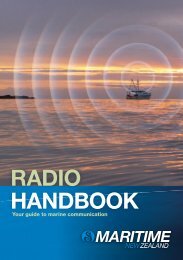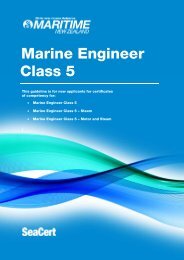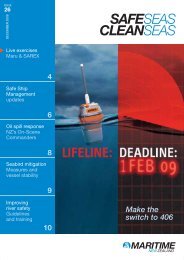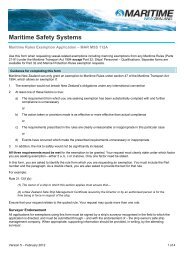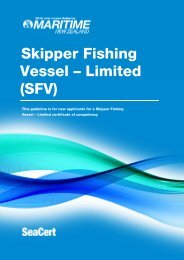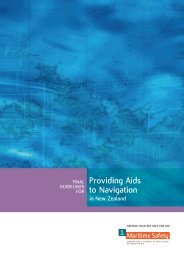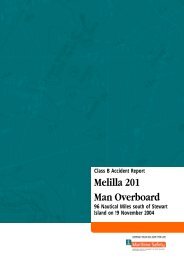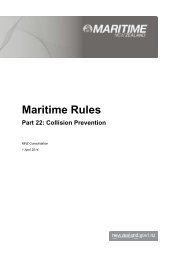New Zealand oil spill response strategy - Maritime New Zealand
New Zealand oil spill response strategy - Maritime New Zealand
New Zealand oil spill response strategy - Maritime New Zealand
Create successful ePaper yourself
Turn your PDF publications into a flip-book with our unique Google optimized e-Paper software.
Appendix 2 - Key Functions and Responsibilities of Regional<br />
Councils<br />
Functions<br />
• To implement the provisions of the regional Marine Oil Spill Contingency Plan within the internal<br />
waters and territorial sea of their region;<br />
• To prepare annual marine <strong>oil</strong> <strong>spill</strong> management business plans, covering plan administration,<br />
training, exercising, and equipment storage and maintenance, and submit these to <strong>Maritime</strong> <strong>New</strong><br />
<strong>Zealand</strong>;<br />
• To approve, audit and monitor Tier 1 site marine <strong>oil</strong> <strong>spill</strong> contingency plans for shore-side <strong>oil</strong><br />
transfer sites within their region, including the internal waters and territorial sea;<br />
• To prepare regional Tier 2 contingency plans;<br />
• To maintain Tier 2 planning and <strong>response</strong> capabilities.<br />
Responsibilities<br />
• Develop and maintain a regional Marine Oil Spill Contingency Plan in accordance with the Marine<br />
Protection Rule and guidelines issued by <strong>Maritime</strong> <strong>New</strong> <strong>Zealand</strong>;<br />
• Complete regional shoreline clean-up and assessment (SCAT) pre-<strong>spill</strong> segmentation of their<br />
coastline;<br />
• Identify and liaise with:<br />
o national agencies;<br />
o regional agencies, including adjacent regional councils;<br />
o district councils;<br />
o industry groups;<br />
o public and environmental groups;<br />
• Formally consult with both the Department of Conservation and regional Tangata Whenua in the<br />
development and review of their plan;<br />
• Identify sensitive environments and establish priorities for protection;<br />
• Develop and maintain a capacity to rescue and rehabilitate <strong>oil</strong>ed wildlife in accordance with<br />
guidelines issued by the <strong>Maritime</strong> <strong>New</strong> <strong>Zealand</strong>;<br />
• Nominate and appoint suitably qualified persons to serve as ROSCs;<br />
• Establish a regional <strong>response</strong> team (e.g., from port companies, industry, councils);<br />
• In addition to responding to a Tier 2 marine <strong>oil</strong> <strong>spill</strong>, to bridge the gap when transitioning from<br />
Tier 2 to Tier 3;<br />
• Provide suitably trained, qualified and experienced <strong>response</strong> personnel for Tier 3 incidents as<br />
required;<br />
• Provide and co-ordinate a regular training programme for personnel with responsibilities for<br />
planning or <strong>response</strong>, in line with the national guidelines;<br />
• Test the plan by conducting regular exercises, in combination with other regions where<br />
appropriate;<br />
• Ensure the safety of all personnel involved in or associated with the <strong>oil</strong> <strong>spill</strong> <strong>response</strong> and cleanup<br />
by complying with the HSE Act;<br />
• Identify facilities for the storage, treatment or disposal of waste from an <strong>oil</strong> <strong>spill</strong>;<br />
• Monitor and enforce legislative provisions;<br />
• Store and maintain the marine <strong>oil</strong> <strong>spill</strong> <strong>response</strong> equipment provided by <strong>Maritime</strong> <strong>New</strong> <strong>Zealand</strong> in<br />
accordance with the terms and conditions of the regional marine <strong>oil</strong> <strong>spill</strong> equipment loan<br />
agreement.<br />
26





